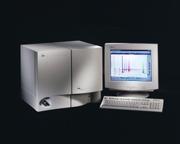|
Instrument Database:
ESA Inc. - 5600A CoulArray
| |
|

|
| |
|
| |
|
| Year of introduction |
|
| Status |
historical ( out of sale ) |
| Company |
ESA Inc.
|
| Categories |
Chromatography: LC-Detector: Electrochemical
|
The CoulArray® detector uses a patented coulometric sensor that overcomes the problems associated with unreliable electrochemical sensor designs. Unlike amperometric electrodes that typically react with less than 10% of the analyte, the coulometric sensor measures 100%. And that means you get optimum results.
These sensors work by applying increasingly higher potentials to the array of electrodes to resolve compounds that differ in redox potential regardless of their chromatographic behavior. An impossible task for multiple amperometric electrodes.
- The advanced capabilities of the CoulArray ensure that you will efficiently and easily get the results you need.
- The qualitative data of PDA with 1,000 times greater sensitivity
- Limits of detection of fluorescence without derivatization
- The widest dynamic response range possible—measuring femtomole to micromole in the same sample
- The only electrochemical detector compatible with gradient chromatography
This unique technology:
- produces qualitative information for compound identification
- resolves co-eluting compounds
- simplifies sample preparation
- measures many compounds in a single sample
The CoulArray is modular by design and can be readily integrated with your HPLC system. It brings to your laboratory advances in selective low-level detection that are simply unobtainable with other technologies.
- Stable response - Unlike conventional amperometric electrochemical detectors, the CoulArray equilibrates rapidly and provides consistent day-to-day response.
- Easier sample preparation - The coulometric array can be fine tuned to exclude inferences. It therefore eliminates or greatly simplifies sample preparation.
- Avoid matrix artifacts - You are able to even trace levels of analytes against a background that includes a multiplicity of other compounds.
- Only Gradient Compatible ECD - The CoulArray is the first electrochemical detector to make gradient operation practical through sophisticated software and unique autoranging capabilities.
- Modular components - Built-in upgradability assures that the capabilities and power of the CoulArray will continue to keep pace with your changing requirements.
|
| Specifications |
|
Number of Electrodes:
4, 8, 12, or 16 coulometric electrodes in series.
Potential Range:
Independent potential control for each electrode from -1 volt to +2 volts in 1 mV increments, accurate to ±1 mV.
Current Ranges:
±50 nA, ±5 µA, ±100 µA autoranged; full scale for each electrode and displayed from 10 pA to 100 µA.
Acquisition Rate:
2 points per second on each channel.
Autozero:
Up to 5 µA on the 50 nA and 5 µA scale and 100 µA on the 100 µA scale.
Output Noise:
< 7 pA peak to peak (10 Mohm, 2 µF, low filter setting).
Output Resolution: 30 fA on 50 nA gain range; 3 pA on 5µA gain range and 47 pA on 100 µA gain range
Power Requirements:
100/120/220/240 V AC, 50/60 Hz.
Output Contact Closures:
8, programmable via software.
Input Contact Closures:
2
Serial Communication Ports:
RS-232 from Computer to: Pump 1, Pump 2, Autosampler, Thermal Chamber
Operating Temperature Range (instrument or control module):
10 - 35° C
Operating Temperature Range (cells):
10 - 45° C
Operating Humidity Range:
40 - 80% relative humidity
Storage Temperature (instrument or control module):
10 - 60° C
Dimensions:
16.75 in. (H) x 10.6 in. (W) x 17.0 in. (D)
(42.5 cm x 27.0 cm x 43.0 cm).
Weight:
12 kg (26 lbs).
Certifications:
UL, CSA, CE.
Data & Control (minimum configuration)
Pentium®-based Computer (Pentium II or higher) 2 GB Hard Disk Drive
SVGA (non interlaced) Monitor 16 MB RAM
3.5" Floppy Disk Drive (1.4 MB) 2 Serial Ports (9-pin)
Color Ink Jet or Laser Printer Parallel Printer Port
Operating System:
MS-Windows® 95/98/NT 4.0
2 Button Mouse
101 Key Keyboard
Data Storage device for archiving
(e.g. Zip-Drive, Tape or CD-R)
All system parameters (flow, detection, data analysis, etc.) are centrally controlled and monitored by the CoulArray® for Windows32 software.
|
|